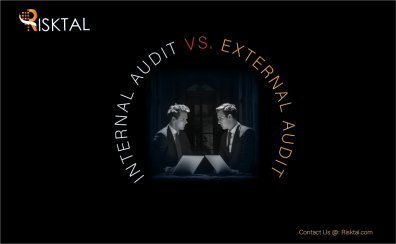
Internal Audit vs. External Audit
Key Differences and Why Both Matter
Audits are essential to the governance and financial health of any organization. They ensure that an organization’s financial statements are accurate, its internal controls are sound, and that it complies with applicable laws and regulations. However, not all audits are the same. Two primary forms of audits that every organization should be familiar with are internal audits and external audits.
While both serve important roles, internal and external audits have distinct objectives, methodologies, and scopes. This article will explore the key differences between these two types of audits, their roles in corporate governance, and why both are critical to the success and sustainability of an organization.
1. Primary Objective: Monitoring vs. Validation
The most fundamental difference between internal and external audits lies in their primary objectives.
Internal Audit: Focus on Continuous Improvement
Internal audits are designed to evaluate and improve the effectiveness of an organization’s internal controls, risk management processes, and governance structures. The primary goal of internal auditors is to ensure that the company operates efficiently, complies with internal policies and external regulations, and effectively manages risks.
Internal auditors focus on a broad range of areas, including operational efficiency, fraud detection, compliance, and risk management. Their goal is to help the organization improve its processes and systems, rather than simply ensuring compliance with external standards.
External Audit: Focus on Financial Accuracy
In contrast, external audits focus primarily on the accuracy and fairness of an organization’s financial statements. External auditors are independent professionals, usually from an auditing firm, who are hired by a company to review its financial records and provide an opinion on whether the financial statements present a true and fair view of the organization’s financial position.
The external audit’s main objective is to provide assurance to shareholders, investors, regulators, and the public that the company’s financial statements are free from material misstatements, whether due to fraud or error. This financial assurance plays a crucial role in maintaining investor confidence and ensuring regulatory compliance.
2. Independence and Reporting Structure
Another key difference between internal and external audits is their reporting lines and independence.
Internal Audit: Reporting to Management and the Board
Internal auditors are typically employees of the organization or outsourced professionals who report directly to senior management or the audit committee of the board of directors. While they are expected to maintain objectivity, their role is to assist the company in improving its operations and internal controls, so they work closely with management.
However, to maintain independence, internal auditors usually have functional reporting lines to the audit committee rather than solely to the company’s executive management. This structure helps ensure that internal auditors can perform their duties without undue influence from company leadership.
External Audit: Independent and Objective
External auditors, on the other hand, must be entirely independent of the organization they audit. They are usually hired by the company’s shareholders or board of directors and have no direct affiliation with the company beyond their professional engagement.
External auditors report their findings to the company’s shareholders, regulatory bodies, and sometimes to the public, depending on the legal requirements. Their independence is crucial to ensuring that their audit opinion is unbiased and based purely on the accuracy of the company’s financial statements.
3. Scope of Work: Broad vs. Narrow Focus
The scope of work for internal and external audits differs significantly.
Internal Audit: Comprehensive and Continuous
Internal audits cover a wide range of areas within the organization. Their scope is determined by the audit plan, which is often risk-based and designed to address key areas of concern for the company. Internal audits may focus on financial processes, but they also examine operational efficiency, compliance with internal policies, IT systems, cybersecurity, fraud detection, and risk management.
Because internal audits are performed throughout the year, they offer a continuous and in-depth look at the organization’s operations and controls. Internal auditors can delve into specific issues, evaluate new risks, and make recommendations for improvement in real-time.
External Audit: Focused on Financial Statements
The scope of an external audit is more focused, typically limited to the company’s financial statements and related disclosures. External auditors examine the company’s financial records, test controls related to financial reporting, and ensure that the company is adhering to accounting standards such as Generally Accepted Accounting Principles (GAAP) or International Financial Reporting Standards (IFRS).
While external audits may include some review of internal controls, their primary concern is whether the financial statements fairly represent the company’s financial position. They do not typically delve into the operational, compliance, or strategic aspects of the business.
4. Frequency and Timing: Periodic vs. Ongoing
The timing and frequency of internal and external audits also set them apart.
Internal Audit: Ongoing Throughout the Year
Internal audits are typically ongoing, with audits conducted on a rolling basis throughout the year. Internal auditors may focus on different departments or functions at different times, ensuring that all aspects of the business are evaluated periodically. This continuous audit process allows for real-time feedback and recommendations for improvements that can be implemented without waiting for the end of the fiscal year.
The audit plan for internal audits is flexible, allowing the audit team to adjust its focus as new risks emerge or as the organization’s priorities shift.
External Audit: Annual or Bi-Annual
External audits, in contrast, are typically conducted once a year, usually at the end of the fiscal year. The primary purpose of an external audit is to provide an independent assessment of the company’s financial statements for that specific reporting period. In some cases, external audits may also be conducted on a semi-annual basis, but they are usually not performed continuously throughout the year.
The timing of the external audit is crucial because the auditor’s opinion is used by stakeholders such as shareholders, investors, and regulatory agencies to assess the company’s financial health and compliance.
5. Impact and Use of Findings
The impact and use of the audit findings differ between internal and external audits, reflecting their different objectives.
Internal Audit: Operational and Strategic Improvements
Internal audit findings are typically used by management and the board to improve internal processes, tighten controls, and address areas of risk. Internal audit reports are not usually shared with external parties unless required by regulators. Instead, they serve as a tool for management to enhance the efficiency and effectiveness of the organization’s operations.
Internal auditors also provide recommendations, which are designed to help management strengthen internal controls and mitigate risks before they escalate into larger issues.
External Audit: Financial Assurance for Stakeholders
External audit findings, specifically the audit opinion, are used primarily by external stakeholders such as shareholders, lenders, investors, and regulators. The external auditor’s report provides assurance that the company’s financial statements are accurate and reliable. This assurance is critical for maintaining investor confidence, securing financing, and meeting regulatory requirements.
If the external audit identifies material weaknesses or misstatements, it could lead to negative consequences, such as restating financials, regulatory fines, or a decline in the company’s stock price.
6. Why Both Internal and External Audits Are Critical
While internal and external audits have different objectives and scopes, both play essential roles in an organization’s overall governance framework.
- Internal audits help organizations identify and manage risks, improve operations, and strengthen internal controls. They provide management with the tools to run the business efficiently and mitigate potential threats.
- External audits provide assurance to external stakeholders that the company’s financial statements are accurate and that the company is operating in compliance with accounting standards and regulations. They help build trust with investors, creditors, and regulators.
Together, internal and external audits complement each other, ensuring that an organization’s financial reporting is accurate, its internal controls are effective, and its operations are running efficiently.
Conclusion: A Balanced Approach to Governance
Both internal and external audits are essential to an organization’s governance, risk management, and compliance frameworks. Internal audits provide continuous assurance and improvements across a broad range of areas, while external audits offer an independent, objective evaluation of the company’s financial statements.
To achieve strong corporate governance, organizations must strike a balance between these two types of audits. By leveraging both internal and external audit functions, businesses can ensure that they are not only compliant with regulatory requirements but also equipped to manage risks and seize opportunities for growth.






